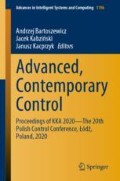Abstract
We present models focused on the control mechanisms in cell cycle, allowing to predict the propagation of faults and its consequences for the cell fate. Development of such models is a two-stage process. First a graph representing molecules and interaction among them is built, through an extensive search of bioinformatic databases and publications. Such graph can be subsequently used to find cutting nodes, representing proteins or complexes or cutting edges, representing biochemical processes that are needed by control mechanisms. The second step is modeling and development of a dynamical model, e.g. in the form of ordinary differential equations that describe changes in concentration of the molecules involved in control mechanisms.
Access this chapter
Tax calculation will be finalised at checkout
Purchases are for personal use only
References
Alberts, B., Johnson, A., Lewis, J., Raff, M., Roberts, K., Walter, P.: Molecular Biology of the Cell, 4th edn. Garland Science, New York (2002)
Neurath, H., Walsh, K.A.: Role of proteolytic enzymes in biological regulation (a review). Proc. Natl. Acad. Sci. 73(11), 3825–3832 (1976)
Saier, M.J.: Classification of transmembrane transport systems in living organisms. In: Van Winkle, L. (ed.) Biomembrane transport. Academic Press, San Diego (1999)
Todeschini, A.L., Georges, A., Veitia, R.A.: Transcription factors: specific DNA binding and specific gene regulation. Trends Genet. 30(6), 211–219 (2014)
Glisovic, T., Bachorik, J.L., Yong, J., Dreyfuss, G.: RNA-binding proteins and post-transcriptional gene regulation. FEBS Lett. 582(14), 1977–1986 (2008)
Pomerening, J.R.: Positive-feedback loops in cell cycle progression. FEBS Lett. 583(21), 3388–3396 (2009)
Puszynski, K., Hat, B., Lipniacki, T.: Oscillations and bistability in the stochastic model of p53 regulation. J. Theor. Biol. 254(2), 452–465 (2008)
Jonak, K., Kurpas M., Puszynski, K.: Prediction of the behavior of mammalian cells after exposure to ionizing radiation based on the new mathematical model of ATM-Mdm2-p 53 regulatory pathway. In: Piętka, E. Kawa, J., Wieclawek, W. (eds.) Information Technologies in Biomedicine, pp. 349–362. Springer, Cham (2014)
De Bont, R., van Larebeke, N.: Endogenous DNA damage in humans: a review of quantitative data. Mutagenesis 19(3), 169–185 (2004)
Houtgraaf, J.H., Versmissen, J., van der Giessen, W.J.: A concise review of DNA damage checkpoints and repair in mammalian cells. Cardiovasc Revasc. Med. 7(3), 165–172 (2006)
Dolbniak, M., Kimmel, M., Smieja, J.: Modeling epigenetic regulation of PRC1 protein accumulation in the cell cycle. Biol. Direct 10, 62 (2015)
Jonak, K., Kurpas, M., Szoltysek, K., Janus, P., Abramowicz, A., Puszynski, K.: A novel mathematical model of ATM/p53/NF- κB pathways points to the importance of the DDR switch-off mechanisms. BMC Syst. Biol. 10(1), 75 (2016)
Hat, B., Kochańczyk, M., Bogdał, M.N., Lipniacki, T.: Feedbacks, bifurcations, and cell fate decision-making in the p53 system. PLoS Comput. Biol. 12(2), e1004787 (2016)
Wang, D.G., Wang, S., Huang, B., Liu, F.: Roles of cellular heterogeneity, intrinsic and extrinsic noise in variability of p53 oscillation. Sci Rep. 9(1), 5883 (2019)
Goldbeter, A.: A minimal cascade model for the mitotic oscillator involving cyclin and cdc2 kinase. Proc. Natl. Acad. Sci. 88(20), 9107–9111 (1991)
Pietenpol, J.A., Stewart, Z.A.: Cell cycle checkpoint signaling: cell cycle arrest versus apoptosis. Toxicology 181–182, 475–481 (2002)
Branzei, D., Foiani, M.: Regulation of DNA repair throughout the cell cycle. Nat. Rev. Mol. Cell Biol. 9(4), 297–308 (2008)
Hat, B., Puszynski, K., Lipniacki, T.: Exploring mechanisms of oscillations in p53 and nuclear factor-β systems. IET Syst. Biol. 3, 342–355 (2009)
Cooper, G., Hausman, R.: The Cell: A Molecular Approach, 6th edn. Sinauer Associates, Sunderland (2013)
DeMars, R., Held, K.R.: The spontaneous azaguanine-resistant mutants of diploid human fibroblasts. Humangenetik 16(1), 87–110 (1972). https://doi.org/10.1007/BF00393992
Loeb, L.A.: A mutator phenotype in cancer. Cancer Res. 61(8), 3230–3239 (2001)
Rohlin, A., Zagoras, T., Nilsson. S., Lundstam, U., Wahlström, J., Hultén, L., Martinsson, T., Karlsson, G.B., Nordling, M.: A mutation in POLE predisposing to a multi-tumour phenotype. Int. J. Oncol. 45(1), 77–81 (2014)
Popat, S., Hubner, R., Houlston, R.S.: Systematic review of microsatellite instability and colorectal cancer prognosis. J. Clin. Oncol. 23(3), 609–618 (2005)
Kohn, K., Bohr, V.: Genomic instability and DNA repair. In: Alison, M. (ed.) The Cancer Handbook. Macmillan, Palgrave (2005)
Widel, M., Krzywon, A., Gajda, K., Skonieczna, M., Rzeszowska-Wolny, J.: Induction of bystander effects by UVA, UVB, and UVC radiation in human fibroblasts and the implication of reactive oxygen species. Free Radic. Biol. Med. 68, 278–287 (2014)
Puszynski, K., Jaksik, R., Swierniak, A.: Regulation of P53 by Sirna in radiation treated cells: simulation studies. Int. J. Appl. Math. Comput. Sci. 22(4), 1011–1018 (2012)
Cieslar-Pobuda, A., Saenko, Y., Rzeszowska-Wolny, J.: PARP-1 inhibition induces a late increase in the level of reactive oxygen species in cells after ionizing radiation. Mutation Res. Fundam. Mol. Mech. Mutagenesis 732(1–2), 9–15 (2012)
Harris, S.L., Levine, A.J.: The p53 pathway: positive and negative feedback loops. Oncogene 24(17), 2899–2908 (2005)
Haupt, Y., et al.: Mdm2 promotes the rapid degradation of p 53. Nature 387(6630), 296–299 (1997)
Cantley, L.C., Neel, B.G.: New insights into tumor suppression: PTEN suppresses tumor formation by restraining the phosphoinositide 3-kinase AKT pathway. Proc. Natl. Acad. Sci. 96(8), 4240–4245 (1999)
Johnson, D.G., Schneider-Broussard, R.: Role of E2F in cell cycle control and cancer. Front Biosci 3, 447–448 (1998)
Lee, M., Rivera-Rivera, Y., Moreno, C.S., Saavedra, H.I.: The E2F activators control multiple mitotic regulators and maintain genomic integrity through Sgo1 and BubR1. Oncotarget 8(44), 77649–77672 (2017)
Swierniak, A., Kimmel, M., Smieja, J., Puszynski, K., Psiuk-Maksymowicz, K.: System Engineering Approach to Planning Anticancer Therapies. Springer International Publishing, Cham (2016). https://doi.org/10.1007/978-3-319-28095-0
Acknowledgment
This work was partially supported by Silesian University of Technology internal grant in the year 2020.
Author information
Authors and Affiliations
Corresponding author
Editor information
Editors and Affiliations
Rights and permissions
Copyright information
© 2020 Springer Nature Switzerland AG
About this paper
Cite this paper
Smieja, J., Swierniak, A., Jaksik, R. (2020). Cell Cycle as a Fault Tolerant Control System. In: Bartoszewicz, A., Kabziński, J., Kacprzyk, J. (eds) Advanced, Contemporary Control. Advances in Intelligent Systems and Computing, vol 1196. Springer, Cham. https://doi.org/10.1007/978-3-030-50936-1_47
Download citation
DOI: https://doi.org/10.1007/978-3-030-50936-1_47
Published:
Publisher Name: Springer, Cham
Print ISBN: 978-3-030-50935-4
Online ISBN: 978-3-030-50936-1
eBook Packages: Intelligent Technologies and RoboticsIntelligent Technologies and Robotics (R0)

